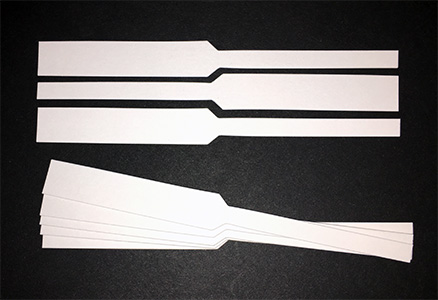Guide to Evaluating the Aroma of an Essential Oil

If you're like me, it's natural to want to sniff an essential oil directly from the bottle. Seriously, how can we not? When the essential oil(s) that we ordered arrives in the mail, we so eagerly want to open our precious new aromatics, lift each bottle to our nostrils, one by one, and take a big sniff.
But...
Assessing the aroma of an essential oil by simply sniffing directly from the bottle is not ideal. I'm not entirely suggesting that you stop sniffing your essential oils from the bottle if you are striving for immediate gratification or eagerly want to get a quick impression of the aroma, but don't form an opinion of a particular essential oil strictly by doing that. Plus, continually opening and closing an essential oil bottle can accelerate the oxidation of the oil.
When you sniff directly from an essential oil bottle, the thin neck of the bottle can be extremely limiting because it doesn't allow an essential oil to fully divulge its complexity and its full palette of aromatic notes. Additionally, if any other essential oil has come in contact with the label or bottle, that aromatic residue can potentially interfere with your ability to accurately assess the aroma of the essential oil inside the bottle.
When needing a quick assessment, it's better to remove the cap to the essential oil, turn the cap upside down and sniff the inside of the cap. Having said that, sniffing from the cap is still not the best way to fully assess the aroma of an essential oil. However, it generally can give you a better overall idea than smelling into the neck of the bottle itself.
Recommended Method for Evaluating the Aroma of an Essential Oil

A much better way to assess the aroma of an essential oil is to apply one or two drops of essential oil to a Fragrance Testing Strip* and evaluate the aroma by sniffing the test strip instead of the bottle or bottle cap.
For a more thorough assessment of the oil as it changes over time, evaluate the aroma by sniffing the strip at set intervals of time, such as immediately after application, and then again after a minute, 5 minutes, 10 minutes, 30 minutes, 1 hour, 6 hours, 12 hours and after 1 day have passed. It can be helpful to keep a notebook to record your aromatic evaluations.
Essential oils are comprised of many types of aromatic molecules, also known as constituents. There can be a hundred or more constituents that are naturally present in an essential oil. Some constituents weight more than others. The lightest constituents, often referred to in perfumery as top notes, evaporate the fastest. The heaviest, known as base notes, tend to evaporate the slowest. Over time, the aroma of an essential oil changes as the different constituents evaporate. Therefore, it can be helpful to assess the aroma of an essential oil over time instead of solely after initial application.
If you have the same botanical type of essential oil from different suppliers, it can be useful to evaluate the aroma simultaneously by using a different fragrance testing strip for each oil. You can then do a comparison as time passes.

*Fragrance Testing Strips are also known Scent Strips and Fragrance Blotters. Several AromaWeb advertisers sell them. Fragrance Testing Strips tend to be constructed of thick white paper and are often (but not always) about 6" long and have a unique paddle shape.
Olfactory Fatigue
Have you ever gone to someone's home for dinner and immediately noticed the delicious aroma wafting from their kitchen? At first, the aroma smells strong. Then over time, you adapt to the aroma and begin to barely notice it, even if you try. This is referred to as olfactory fatigue, sometimes also known as olfactory adaptation. A similar temporary phenomenon occurs when smelling numerous aromatics within a short interval of time. You're no longer able to fully distinguish an essential oil's aroma or easily distinguish one essential oil from another. Therefore, it's best to only assess one or two essential oils at a time.
Take frequent breaks to minimize the risk of encountering olfactory fatigue during aromatic evaluations. Smelling coffee beans can be helpful in minimizing olfactory fatigue.
